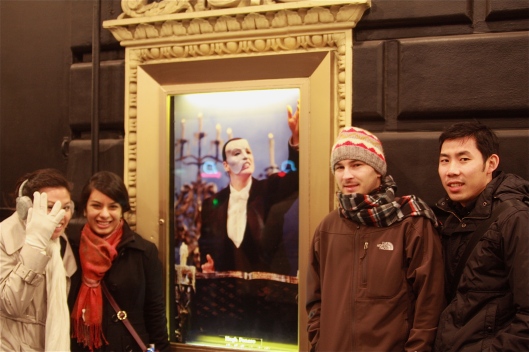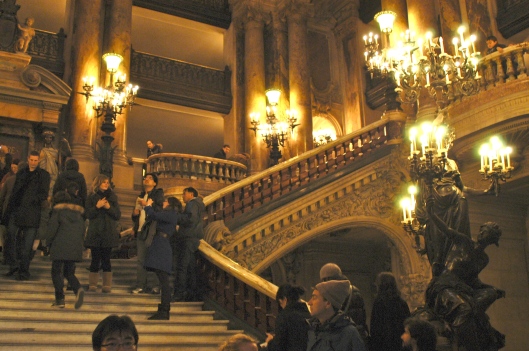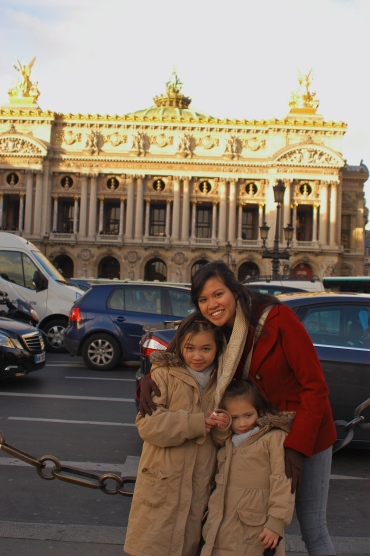
Emmy Russum and Gerard Butler in the movie
I first fell in love with the Phantom of the Opera in middle school band. We did a number compiling the best of Andrew Lloyd Webber’s works, including what was arguably his most famous composition, Phantom of Opera. I remember playing the Timpani, and in-between my drum rolls, I would sway to the music with the pallets in my hands, completely enchanted by the vast number of instruments playing. For this particular concert, the symphony band and the string orchestra collaborated and played together. Even from a middle school band with 13 year-old musicians, the multiple layers of sound produced by the different instrument was phenomenal. The post below is not of us playing, but it is so magnificent to see a performance as such. And being a percussionist at the back of the band, I could see the musicians as a whole while being surrounded and embraced by such beautiful sound. We had an opportunity to experience a glimpse of Lloyd Webber’s masterpiece, and it was glorious.
Then in 2004, Lloyd Webber and Joel Schumacher produce the film adaptation with Emmy Rossum as Christine and Gerard Butler as the Phantom. One of my older friends, more like a big sister, took me to go see it in the movie theater. When the DVD was released, I had it on repeat just for the music to fill the house. My phone’s ringtone was the Overture for a long time. I remember going out on my first few dates. When my Asian mother called, the intense, demanding, and haunting music scared my date. Needless to say, it kept him on his toes.
I finally saw the musical in theatre when I was in New York. We paid the last minute, student, price to sit in the nose-bleed section, but it was still an amazing experience to hear the music for what it was initially composed for, a musical. In the scene when Christine walks through the mirror following the Phantom down the dungeon, the organ plays, Dun, dun dun dun dun dun. I nudged my friend with a load whisper, “This is it! This is it!”
I had a chance to see this epic romantic musical again in Her Majesty Theatre in London. It could never grow old for me. The featured song, Phantom of the Opera, has this rocking roll beat, boom – boom boom- tick, Boom – boom boom- tick, while the female vocalist stretches her voice to a higher and higher octave. As she climbs the scale, the male vocalist serves as a strong bass that compliments her voice. This beautiful harmony is supported by the brass section of the band whom brazzingly announce the significance of the moment when Christine meets the Phantom, and the string instruments that provide a mystifying element to what seems to be an angelic moment. The organ reminds us that this is in fact a “strange duet” between a ghost and a fanciful young girl. Webber’s genius is his ability to translate the mood and feeling of the story into the notes and lines of the music score.
The story itself is no more than a romantic chick-flick, a gothic fantasy about girl, at the start of her stardom. She has not one but two suitors. One is her childhood sweetheart, who also just so happens to be a rich Viscount. He is the charming gentleman, Raul, that will take care of her, come to her rescue riding bareback on a white horse, and sword fight to defend her. On the other hand, she has a deformed genius that secretly plays as the architect, composer, and mastermind of the opera house. The Phantom appeals to her dangerous, bad boy fascination . He is mysterious, talented, and yet pitiful. What I find interesting is that in the original book written by Gaston Leroux, there is more focus on phantom’s story. In fact, in the musical, there is no actual mention of his real name, Eric. The musical’s main character is Christine. It is written to showcase Sarah Brightman, who is the original female lead, and Andrew Lloyd Webber’s former wife. It is their divorce that postponed the movie 10-15 years later. Of course that is never publicly stated.

Michael Crawford and Sarah Brightman in the original 1986 production of The Phantom of the Opera. Photograph: Donald Cooper/Rex Features
Sarah Brightman did not get a chance to play her role in movie. Schumacher, the director, wanted to appeal to a younger audience, privy to Christine’s innocent and naïve character. 16 year old, Emmy Rossum’s voice was beautiful in the movie despite the pressure. Her acting was par, but Brighman’s acting was par as well. It is hard to find an extraordinary singer who is also an extraordinary actor. As for the character of Christine, the actress only had to look helpless or in love.
The other very large shoes that had to filled, was the role of the Phantom. Gerard Butler was not a trained singer, therefore, he had a rough and raw rock-n-roll feature in his voice. Some would consider blasphemy that I make this statement, however, Butler played an even better role of the phantom than Michal Crawford, the original Phantom. Crawford’s Phantom is a sleazy and creepy “creature of darkness.” Butler has the rough masculine voice that adds to the typical female bad-boy fantasy. The audience can then understand why Christine is enchanted by the idea of Phantom.
In Point of No Return, Butler’s Phantom growls over the note as Christine is slowly giving in to him. The audience does so too, especially in this song, with the most eloquent lyric about making love, “entwining” bodies, and the “sleeping bud burst into bloom.” Unlike Crawford, Butler adds a roar to the “raging fire shall flood the soul.” It is quite surprising, as a grown person revisiting familiar song, to understand what they are singing about when they sing, “When will the blood begin to race? What rich desire unlocks its door? What sweet deduction lines before us?” The set and custom for this scene is seductively red and black. In the movie, there is a tango in the background that the play does not have.
There are a number of limits to what can be seen on the stage of a theatre. In the movie we can see the set in its entirety. On the theatre stage however, we can appreciate the wise use of space that the designers so craftily planned. The masquerade scene on stage was asymmetrical, conveying the large scale of the opera house without having to complete the whole staircase. The set designers left the rest to the imagination. In another scene, after Christine is debuted on her first show, the stage is flipped. The audience sees the back of Christine as she bows towards an actor that plays the conductor, and behind him, a black screen that conveys an audience. A curtain closes, and her ballerina friends run to congratulate her. This was a cleaver stage trick that invites the audience to see the behind the scene production side of the opera house.

Masquerade Scene on the Staircase on Stage
This play is about a play of plays, so it was fun to see the production of the play as part of the play, making the audience feel included in mystery of the phantom of the opera house. I did get a chance to walk in the real Opera de Paris Garnier, where the story takes place. Charles Garnier for the Emperor Napoleon III built this gilded baroque theatre in the 1860s. I did not get to see the water canal underneath the opera house, but it does exist due to Garner’s construction. I saw where the famous chandelier hangs. On 20 May 1896, one of the counterweight of the chandelier fell and killed an audience member. We cannot confirm or deny that was the workings of the Phantom; however, this was the story that inspired Gaston Leroux to write the book.




